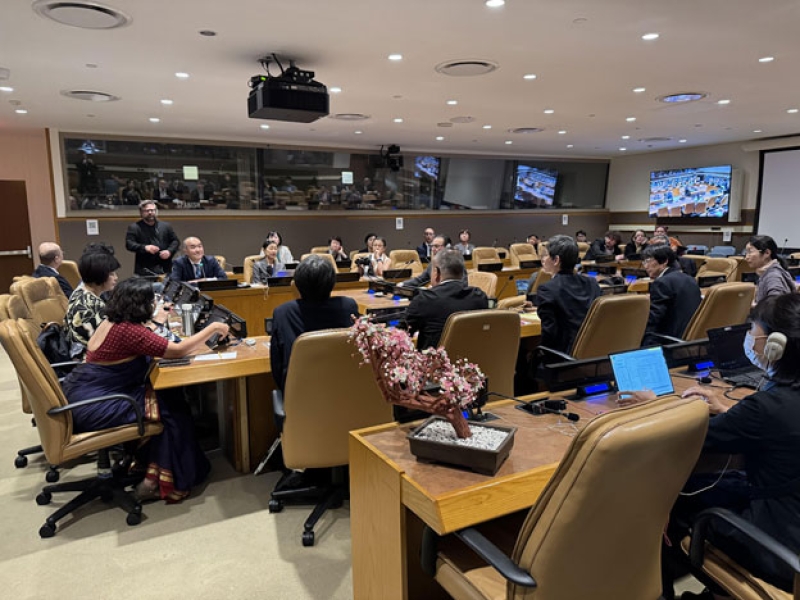- CA Yunus pays homage to Liberation War martyrs on Victory Day |
- Bangladesh capital market extends losing streak for second day |
- Bangladesh celebrates Victory Day Tuesday |
- 'Different govts presented history based on their own ideologies': JU VC |
Japan’s Eugenics Victims Demand Justice, Share Stories

At the United Nations Headquarters in New York. Credit: Maximilian Malawista
Victims of Japan’s costly Eugenic Protection Law took to the stage to share their life stories, offering accounts of sterilization and mutilation in the hope of building “a society without discrimination.”
At a side event titled International Sharing of the Experiences and Lessons of Japan’s Former Eugenic Protection Law, held on June 10 during the Conference of States Parties to the Convention on the Rights of Persons with Disabilities, participants discussed the struggle against eugenic ideology.
Hosted by the Japan Disability Forum along with several legal defense teams for the victims, the event presented an overview of ideology, policy, and reparations, aimed at fighting “eugenics-based discrimination.”
Japan’s Eugenic Protection Law was enacted in 1948, three years after the Japanese Axis forces surrendered to the Allied powers in World War II. Although repealed in 1996, the damage had already been done, and few understood the full extent.
Twenty-five thousand people—either living with disabilities or suspected of having them—were forcibly sterilized, without apology or compensation.
The side event was opened by Hiroshi Tamon, a lawyer on the defense team against the Eugenic Protection Law. Tamon, who is deaf, conveyed his message through sign language, stating that the event aimed to “share the experiences of Japanese victims with disabilities and disability organizations who have fought a long and difficult struggle to change Japanese society by eliminating eugenic ideology.”
He concluded with a call to “inspire and lead global action to eliminate eugenics ideology and forced sterilization worldwide,” making it clear he hopes Tokyo’s legal efforts will inspire change beyond Japan.
In 2018, one victim, Kita Saburo, came forward. Represented by lawyer Naoto Sekiya, Kita was awarded 15 million yen (approximately USD 103,000). This triggered a wave of lawsuits in 2019, culminating in a ruling from Japan’s Supreme Court that the Eugenic Protection Law was unconstitutional. Compensation for victims was then set at 3.2 million yen (approx. USD 22,000).
The law faced further criticism for its limited financial scope and eligibility, leading to another lawsuit in 2024. The Prime Minister of Japan later issued a public apology and vowed to “work towards ending all discrimination and strengthen educational efforts to build a new structure.”
Two days later, the government issued an order to eliminate discrimination in society, and established the Headquarters for the Promotion of Measures toward the Realization of a Coexisting Society Free from Prejudice and Discrimination against Persons with Disabilities.
An action plan followed, aimed at promoting an inclusive society and ensuring compensation for all victims and their spouses.
In January 2024, victims of forced sterilization began receiving the full 15 million yen. But by the end of April, only 1,325 individuals—just 1.5% of those affected—had applied for compensation.
To improve outreach, the government and disability organizations have pledged to expand access to information through alternative communication methods.
The Story of Kita Saburo
At the age of 14, while in a juvenile detention facility, Kita underwent an unexplained surgery. Authorities told him only that they were “removing the bad part.” A month later, a senior staff member informed him that the surgery had made him infertile.
The facility had determined that Kita’s behavior stemmed from a supposed mental disability.
Kita’s sister knew of the procedure but had been strictly instructed by their grandmother to remain silent. For years, Kita believed it was his parents who had authorized the surgery, leading to deep resentment.
Later in life, he married but was unable to tell his wife the truth. The couple frequently faced questions like “Still no children?”, causing emotional pain. Kita finally told his wife about the surgery as she lay on her deathbed.
In 2018, Kita filed a lawsuit against the Japanese government after learning he was not alone—and that his parents were not responsible. His sister testified in court just before she passed away during the trial.
Although the court ruled in his favor, Kita said: “No matter what verdict is handed down, it does not mean we can start our lives over. Eugenic surgery is a tragedy that cannot be undone.”
“I want to reduce the number of people who suffered the way I did, even if it’s just one,” he said. “That’s why I’ve chosen to speak out and share my story. I sincerely hope that Japan and the world become places where everyone can make decisions for themselves.”
Kita’s story highlights how the Eugenic Protection Law’s definition of disability was so broad that even those not deemed intellectually disabled were subjected to the procedure.
Following his testimony, a couple—Keiko and Takashi Onoue—and Yumi Suzuki also appeared via video to share their stories.

